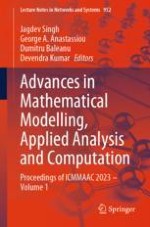2024 | OriginalPaper | Buchkapitel
A Mathematical Study of Reproduction Number and Its Control Strategies in Some Early Epidemic and Corona-Virus Epidemic Model
verfasst von : Abhishek Sarkar, Kulbhushan Agnihotri, Krishna Pada Das
Erschienen in: Advances in Mathematical Modelling, Applied Analysis and Computation
Verlag: Springer Nature Switzerland
Aktivieren Sie unsere intelligente Suche, um passende Fachinhalte oder Patente zu finden.
Wählen Sie Textabschnitte aus um mit Künstlicher Intelligenz passenden Patente zu finden. powered by
Markieren Sie Textabschnitte, um KI-gestützt weitere passende Inhalte zu finden. powered by
